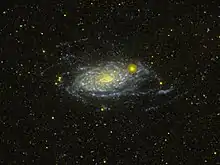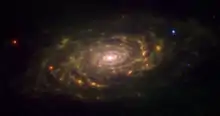| Messier 63 | |
|---|---|
.jpg.webp) Image taken by Hubble Space Telescope, on November 16, 2001 at 450 and 814 nm[1] | |
| Observation data (J2000 epoch) | |
| Constellation | Canes Venatici |
| Right ascension | 13h 15m 49.27385s[2] |
| Declination | +42° 01′ 45.7261″[2] |
| Redshift | 484 km/s[3] |
| Distance | 29.3 Mly (8.99 Mpc)[4] |
| Group or cluster | M51 Group |
| Apparent magnitude (V) | 9.3[3] |
| Characteristics | |
| Type | SAbc[5] |
| Apparent size (V) | 12.6′ × 7.2′[3] |
| Other designations | |
| M63, NGC 5055, PGC 46153, UGC 8334[3] | |

Messier 63 or M63, also known as NGC 5055 or the seldom-used Sunflower Galaxy,[6] is a spiral galaxy in the northern constellation of Canes Venatici with approximately 400 billion stars.[7] M63 was first discovered by the French astronomer Pierre Méchain, then later verified by his colleague Charles Messier on June 14, 1779.[6] The galaxy became listed as object 63 in the Messier Catalogue. In the mid-19th century, Anglo-Irish astronomer Lord Rosse identified spiral structures within the galaxy, making this one of the first galaxies in which such structure was identified.[8]
The shape or morphology of this galaxy has a classification of SAbc,[5] indicating a spiral form with no central bar feature (SA) and moderate to loosely wound arms (bc). There is a general lack of large-scale continuous spiral structure in visible light, so it is considered a flocculent galaxy. However, when observed in the near infrared, a symmetric, two-arm structure is seen. Each arm wraps 150° around the galaxy and extends out to 13,000 light-years (4,000 parsecs) from the nucleus.[9]
M63 is a weakly active galaxy with a LINER nucleus – short for 'low-ionization nuclear emission-line region'. This displays as an unresolved source at the galactic nucleus that is cloaked in a diffuse emission. The latter is extended along a position angle of 110° relative to the north celestial pole, and both soft X-rays and hydrogen (H-alpha) emission can be observed coming from along nearly the same direction.[10] The existence of a supermassive black hole (SMBH) at the nucleus is uncertain; if it does exist, then the mass is estimated as (8.5±1.9)×108 M☉,[11] or around 850 million times the mass of the Sun.
Radio observations at the 21-cm hydrogen line show the gaseous disk of M63 extends outward to a radius of 130,000 light-years (40 kiloparsecs), well past the bright optical disk. This gas shows a symmetrical form that is warped in a pronounced manner, starting at a radius of 33,000 light-years (10 kiloparsecs). The form suggests a dark matter halo that is offset with respect to the inner region. The reason for the warp is unclear, but the position angle points toward the smaller companion galaxy, UGC 8313.[12]
The distance to M63, based upon the luminosity-distance measurement is 29,300,000 light-years (8.99 megaparsecs).[4] The radial velocity relative to the Local Group yields an estimate of 15,200,000 light-years (4.65 megaparsecs).[5] Estimates based on the Tully–Fisher relation range over 16,000,000–34,000,000 light-years (5.0–10.3 megaparsecs). The tip of the red-giant branch technique gives a distance of 28,930,000 ± 950,000 light-years (8.87 ± 0.29 megaparsecs).[13] M63 is part of the M51 Group, a group of galaxies that also includes M51 (the 'Whirlpool Galaxy').[14]
In 1971, a supernova with a magnitude of 11.8 appeared in one of the arms. It was discovered on May 24 and reached peak light around May 26.[15] The spectrum of this, SN 1971I, is consistent with a supernova of type I. However, the spectroscopic behavior appeared anomalous.[16]
Gallery

 Messier 63 seen in the infrared by the Spitzer Space Telescope. The infrared radiation traces the dust within the spiral arms, which does not radiate visible light. A small dust ring can be seen just outside of the galaxy's center.[18]
Messier 63 seen in the infrared by the Spitzer Space Telescope. The infrared radiation traces the dust within the spiral arms, which does not radiate visible light. A small dust ring can be seen just outside of the galaxy's center.[18]
See also
References
- ↑ Morrow, Ashley, ed. (September 11, 2015), Hubble Sees a Galactic Sunflower, NASA, retrieved 2018-11-30.
- 1 2 Brown, A. G. A.; et al. (Gaia collaboration) (August 2018). "Gaia Data Release 2: Summary of the contents and survey properties". Astronomy & Astrophysics. 616. A1. arXiv:1804.09365. Bibcode:2018A&A...616A...1G. doi:10.1051/0004-6361/201833051.
- 1 2 3 4 "NASA/IPAC Extragalactic Database". Results for NGC 5055. Retrieved 2006-10-10.
- 1 2 Tully, R. Brent; et al. (August 2016), "Cosmicflows-3", The Astronomical Journal, 152 (2): 21, arXiv:1605.01765, Bibcode:2016AJ....152...50T, doi:10.3847/0004-6256/152/2/50, S2CID 250737862, 50.
- 1 2 3 Ann, H. B.; et al. (2015), "A Catalog of Visually Classified Galaxies in the Local (z ~ 0.01) Universe", The Astrophysical Journal Supplement Series, 217 (2): 27–49, arXiv:1502.03545, Bibcode:2015ApJS..217...27A, doi:10.1088/0067-0049/217/2/27, S2CID 119253507.
- 1 2 Garfinkle, Robert A. (1997), Star-Hopping: Your Visa to Viewing the Universe, Cambridge University Press, p. 258, ISBN 978-0521598897.
- ↑ "Messier 63 - M63 - The Sunflower Galaxy (Spiral Galaxy) | freestarcharts.com". freestarcharts.com. Retrieved 2020-06-23.
- ↑ Jones, K. G. (1991), Messier's Nebulae and Star Clusters (2nd ed.), Cambridge: Cambridge University Press, ISBN 978-0-521-37079-0.
- ↑ Thornley, Michele D. (September 1996), "Uncovering Spiral Structure in Flocculent Galaxies", Astrophysical Journal Letters, 469: L45, arXiv:astro-ph/9607041, Bibcode:1996ApJ...469L..45T, doi:10.1086/310250, S2CID 9003459.
- ↑ Masegosa, J.; et al. (March 2011), "The nature of nuclear Hα emission in LINERs", Astronomy & Astrophysics, 527: 28, arXiv:1011.0865, Bibcode:2011A&A...527A..23M, doi:10.1051/0004-6361/201015047, S2CID 116978210, A23.
- ↑ Graham, Alister W. (November 2008), "Populating the Galaxy Velocity Dispersion - Supermassive Black Hole Mass Diagram: A Catalogue of (Mbh, σ) Values", Publications of the Astronomical Society of Australia, 25 (4): 167–175, arXiv:0807.2549, Bibcode:2008PASA...25..167G, doi:10.1071/AS08013, S2CID 89905.
- ↑ Battaglia, G.; et al. (February 2006), "ion{H}{i} study of the warped spiral galaxy NGC 5055: a disk/dark matter halo offset?", Astronomy and Astrophysics, 447 (1): 49–62, arXiv:astro-ph/0509382, Bibcode:2006A&A...447...49B, doi:10.1051/0004-6361:20053210, S2CID 119353199.
- ↑ McQuinn, Kristen. B. W.; et al. (August 2017), "Accurate Distances to Important Spiral Galaxies: M63, M74, NGC 1291, NGC 4559, NGC 4625, and NGC 5398", The Astronomical Journal, 154 (2): 13, arXiv:1706.06586, Bibcode:2017AJ....154...51M, doi:10.3847/1538-3881/aa7aad, S2CID 119449804, 51.
- ↑ Tikhonov, N. A.; et al. (September 2009), "Stellar content of the interacting galaxies of the M51 system", Astronomy Letters, 35 (9): 599–608, Bibcode:2009AstL...35..599T, doi:10.1134/S1063773709090035, S2CID 123044805.
- ↑ Barbon, R.; et al. (1973), "Observations of five supernovae 1970-71", Memorie della Società Astronomia Italiana, 44: 65, Bibcode:1973MmSAI..44...65B.
- ↑ Deming, Drake; et al. (June 1973), "The Light Curve of Supernova 1971 I", Publications of the Astronomical Society of the Pacific, 85 (505): 321, Bibcode:1973PASP...85..321D, doi:10.1086/129462
- ↑ Bai, Yu; Zou, Hu; Liu, JiFeng; Wang, Song (September 2015). [ttpsh://doi.org/10.1088/0067-0049/220/1/6 "An Updated Ultraviolet Catalog of Galex Nearby Galaxies"]. The Astrophysical Journal Supplement Series. 220 (1): 6. arXiv:1508.07071. Bibcode:2015ApJS..220....6B. doi:10.1088/0067-0049/220/1/6. S2CID 118402184. Retrieved 21 October 2021.
- ↑ spitzer. "Spitzer's Sunflower". Spitzer Space Telescope. JPL-Caltech. Retrieved 21 October 2021.
External links
- The Sunflower Galaxy on WikiSky: DSS2, SDSS, GALEX, IRAS, Hydrogen α, X-Ray, Astrophoto, Sky Map, Articles and images
- Sunflower Galaxy @ SEDS Messier pages
- Sunflower Galaxy (M63) at Constellation Guide
